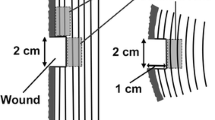Summary
Holes were drilled almost through 15 trunks each of Acer rubrum, A. saccharum, and Betula papyrifera. Dissections after 2 and 3 years showed that the uninjured cambium distal to the ends of the drill holes formed barrier zones and wider growth rings, indicating that some message must have been sent from injured wood through healthy wood to the cambium.
Similar content being viewed by others
References
Banfield, W. M. 1968: Dutch elm disease recurrence and recovery in American elm. Mass. Agric. Exp. Bul. 568: 60 pp.
Buisman, C. 1935: The anatomy of wood of elms infected with Graphium ulmi. Translation by E. W. J. Reyers, 1937; From laboratory reports Willie Commelin Scholten. Baarn. Tijdschr. Plantenziekt. 104–120. Rev. Appl. Mycol. 14: 664
Marchetti, M. A. 1962: Reaction of Quercus macrocarpa to infection by Ceratocystis fagacearum. Ph.D. Diss. Iowa State Univ. Library, Ames, Iowa. 114 p.
Moore, K. E. 1978: Barrier zone formation in wounded stems of sweetgum (Liquidambar styraciflua). Can. J. For. Res. 8: 389–397
Mulhern, J.; Shortle, W. C.; Shigo, A. L. 1979: Barrier zones in red maple: an optical and scanning microscope examination. For. Sci. 25:311–316
Mullick, D. B. 1977: The non-specific nature of defense in bark and wood during wounding, insect and pathogen attack. Phytochemistry 11: 395–441
Pearce, R. B.; Rutherford, J. 1981: A wound associated suberized barrier to the spread of decay in sapwood of oak Quercus rubra L. Physiol. Plant Pathol. 19: 359–369
Schoeneweiss, D. F. 1959: Xylem formation as a factor in oak wilt resistance. Phytopathology 49: 335–337
Sharon, E. M. 1973: Some histological features of Acer saccharum wood formed after wounding. Can. J. For. Res. 3: 83–89
Shigo, A. L. 1984: Tree defects: A Photo Guide. USDA For. Serv. Res. Paper NE-82: 169 pp.
Shigo, A. L.; Tippett, J. T. 1981: Compartmentalization of American elm tissues infected by Ceratocystis ulmi. Plant Dis. 65: 715–718
Tippett, J. T.; Shigo, A. L. 1981a: Barriers to decay in conifer roots. Eur. J. For. Pathol. 11: 51–59
Tippett, J. T.; Shigo, A. L. 1981b: Barrier zone formation: A mechanism of tree defense against vascular pathogens. IAWA Bull. 2: 163–168
Tippett, J. T. 1982: Shedding of ephemeral roots in gymnosperms. Can. J. Bot. 60: 2295–2302
Author information
Authors and Affiliations
Additional information
We thank Dr. Joanna Tippett for assistance during the study, and for criticism of this paper
Rights and permissions
About this article
Cite this article
Shigo, A.L., Dudzik, K.R. Response of uninjured cambium to xylem injury. Wood Sci. Technol. 19, 195–200 (1985). https://doi.org/10.1007/BF00392048
Received:
Issue Date:
DOI: https://doi.org/10.1007/BF00392048




